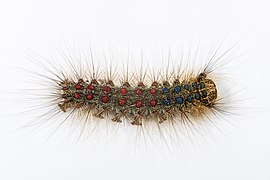Lymantria dispar
Lymantria dispar Linnaeus ye un lepidópteru de la familia Lymantriidae, d'orixe eurásico. Orixinalmente topada d'Europa a Asia, siendo introducida a Norteamérica a fines de 1860s, ampliando'l so rangu. Tamién la conoz como poliya xitana asiática.[1][2]
Lymantria dispar | ||
|---|---|---|
 | ||
| Clasificación científica | ||
| Reinu: | Animalia | |
| Filu: | Arthropoda | |
| Clas: | Insecta | |
| Orde: | Lepidoptera | |
| Familia: | Lymantriidae | |
| Xéneru: | Lymantria | |
| Especie: |
L. dispar (Linnaeus, 1758) | |
| Sinonimia | ||
| ||
| Consultes | ||
| [editar datos en Wikidata] | ||
Nel so estáu d'imagu tien un marcáu dimorfismu sexual, la fema tien ales carauterístiques de color blancu; amás ye bien cabileñu, siendo incapaz de volar. El so ciclu completu dura un añu.
Les caparines apariense en xunetu, asitiando la puesta en forma de carauterísticos plastones de color mariellu. Los güevos son bien resistentes al fríu. Yá en primavera eclosionan los güevos, y nacen les gates, que van sufrir cuatro o cinco mudes hasta pasar a la fase de imagu. Trátase d'un defoliador, que n'España ataca principalmente al xéneru Quercus, anque puede atacar a otres frondosas.
-
Canesba.
-
♀
-
♂
Referencies
editarBibliografía
editar- Barbosa, P. & Greenblatt, J. 1979. Suitability, digestibility and assimilation of various host plants of the gypsy moth Lymantria dispar L. (Lepidoptera, Lymantriidae). Oecologia 43(1): 111-119
- Barbosa, P.; Waldvogel, M.; Martinat, P. et al. 1983. Developmental and reproductive performance of the gypsy moth, Lymantria dispar (Linnaeus) (Lepidoptera, Lymantriidae), on selected hosts common to mid-atlantic and southern forests. Environmental Entomology 12(6): 1858-1862
- Dwyer, G. & Elkinton, J.S. 1993. Using simple-models to predict virus epizootics in gypsy-moth populations. Journal of Animal Ecology 62(1): 1-11
- Elkinton, J.S.; Healy, W.M.; Buonaccorsi, J.P.; Boettner, G.H.; Hazzard, A.M.; Smith, H.R. & Liebhold, A.M. 1996. Interactions among gypsy moths, white-footed mice, and acorns. Ecology 77(8): 2332-2342
- Fullard, James H. & Napoleone, Nadia. 2001. Diel flight periodicity and the evolution of auditory defences in the Macrolepidoptera. Animal Behaviour 62(2): 349–368. doi 10.1006/anbe.2001.1753 10.1006/anbe.2001.1753 PDF completu
- Gansner, D.A.; Herrick, O.W.; Mason, G.N. & Gottschalk, K.W. 1987. Coping with the gypsy moth on new frontiers of infestation. Southern Journal of Applied Forestry Research 11: 201-209
- Gould, J.R.; Elkinton, J.S. & Wallner, W.E. 1990. Density-dependent suppression of experimentally created gypsy moth, Lymantria dispar (Lepidoptera, Lymantriidae), populations by natural enemies. Journal of Animal Ecology 59(1): 213-233
- Porter, Jim. 1997. The Colour Identification Guide to Caterpillars of the British Isles (Macrolepidoptera). Viking, London. páxs. 81
- Rossiter, M.C. 1991. Maternal effects generate variation in life-history - consequences of egg weight plasticity in the gypsy moth. Functional Ecology 5(3): 386-393
- Waring, P., Townsend, M. and Lewington, R. 2003. Field Guide to the Moths of Great Britain and Ireland. British Wildlife Publishing, Hook, UK. páxs. 211
- Weseloh, R.M. & Andreadis, T.G. 1992. Epizootiology of the fungus Entomophaga maimaiga, and its impact on gypsy moth populations. Journal of Invertebrate Pathology 59(2): 133-141
Enllaces esternos
editar| Wikispecies tien un artículu sobre Lymantria dispar. |
- asiangypsymoth.org Archiváu 2013-05-21 en Wayback Machine
- Poliya gitana en Marruecos
- Acerca de Entomophaga maimaiga
- Species Profile- European Gypsy Moth (Lymantria dispar), National Invasive Species Information Center, United States National Agricultural Library. Listas generales informativas y recursos de la poliya gitana europea


